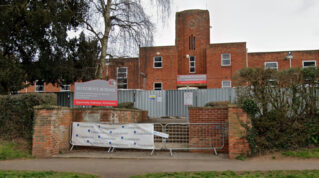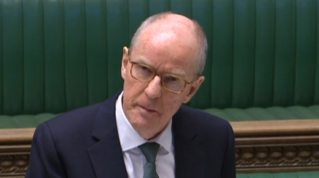Years of chronic underinvestment mean 700,000 children are being educated in school buildings needing major repairs, with a £2 billion yearly shortfall in funding revealed.
A National Audit Office report also found more than a third of school buildings are beyond their “use-by date”, but government lacks “comprehensive information on the extent and severity of potential safety issues”.
The Department for Education has regarded the risk of a fatal building collapse as “critical and very likely” since 2021.
Meg Hillier, chair of the public accounts committee, said “worryingly government does not know how many schools may be unsafe”.
“After years of firefighting issues, parents need reassurance that the department knows where, when and how any risks to their children will be remedied.”
Here’s what you need to know …
1. 38% of school buildings past use-by date
About 24,000 school buildings – representing 38 per cent of the DfE estate – are thought to be “beyond their estimated initial design life”.
Among them are 13,800 “system-built” blocks – which are made from concrete, steel and timber, rather than brick and stone. These were built at speed between 1940 and 1980 with an initial design life of just 30 to 40 years.
“Buildings can normally be used beyond their initial design life with adequate maintenance, but can be more expensive to maintain and, on average, have poorer energy efficiency leading to higher running costs,” the report stated.
But NAO auditor general Gareth Davies, who penned the report, noted the DfE has for the last two years “recognised the significant safety risk across the school estate”.
Its corporate risk register shows as “critical and very likely” the risk that building collapse or failure could cause death or injury.
2. Southern schools in better condition
Condition needs – the cost to fix schools per pupil – varies by area. In 114 local authorities (75 per cent of the total), average condition need per pupil was between £1,000 and £2,000.
However, schools in eight local authorities had an average condition need of more than £2,000 per pupil, while the figure was less than £1,000 per child in 30 councils (20 per cent).
Average condition need per pupil is highest in the east and west Midlands, and generally lower in the south, the report stated.
Schools in Staffordshire had the highest estimated condition need, at £2,600 per pupil, compared with £530 in Torbay.
3. ‘Significant’ £2bn capital funding gap
The department is aware of 56 temporary closures due to structural issues over the last six years.
It also has records of “six concrete and timber-framed system-built blocks which have fully or partially shut” due to “structural instability” over the period.
As of March, DfE was not aware “of any injuries to staff or pupils”.
The DfE estimated it needs £5.3 billion a year in capital funding to “maintain schools and mitigate the most serious risks of building failure”.
The department requested £4 billion a year for 2021 to 2025 from the Treasury, but only got allocated £3.1 billion. This amounted to a “significant gap”.
Davies said this has “contributed to the estate’s deterioration”.
“Given limited funding,” the report explained, “responsible bodies are more likely to prioritise elements of school buildings in the worst condition leaving less to spend on effectively maintaining the other structures and enhancing or developing their estate.”
4. 700k pupils in buildings needing major work
Davies said the estate’s “overall condition is declining” following “years of underinvestment”.
This has resulted in “about 700,000 pupils” having to learn in “a school that the responsible body or DfE believes needs major rebuilding or refurbishment”.
“Although it has made progress in the last year, the department currently lacks comprehensive information on the extent and severity of these safety issues, which would allow it to develop a longer-term plan to address them,” Davies added.
Ministers have identified 572 schools that they believe may contain reinforced autoclaved aerated concrete (RAAC), a material the Office for Government Property previously described as “crumbly” and “liable to collapse”. The report said DfE sees RAAC as the “greatest risk to safety across the school estate”.
They have allocated £6 million for 600 on-site surveys to take place by December. More than 150 schools have been identified as potentially having RAAC, and some have also had to immediately close.
Of the 13,800 system-built blocks, the DfE is most concerned about 3,600 “because they may be more susceptible to deterioration”.
In September last year, government approved plans for assessments of 200 of the worst schools, but it is yet to procure specialists to carry out the first 100 visits.
5. Major rebuilding scheme already falling behind
Davies added that the department is already behind on its 10-year programme – which was launched in 2020 – to rebuild or refurbish 500 schools “in the most urgent need”.
Four-hundred sites have been selected. Twenty-two of them have structures at “high risk of collapse”, while 78 have the highest “condition need” per square meter.
However just 24 contracts have been awarded compared to a forecast of 82, with one project completed compared to its forecast of four.
The reasons for this included a reluctance among contractors to take on jobs due to “instability in the construction sector” as well as “inflationary risks”.
National Education Union joint general secretary Kevin Courtney said the school estate is in “a perilous condition. If we are to prevent something catastrophic happening, such as a building collapse, action must be taken and significant funding put in place.
“The era of hoping such problems will go away of their own accord is over.”
6. 15% of schools have not bid for repairs cash
In 2021-22, the DfE changed its formula for calculating maintenance and repair funding so it included data on the condition of school buildings. But NAO analysis suggested the tweaks “may not fully reflect the actual work needed”.
The funding is directly allocated to academy trusts and councils with at least five schools and 3,000 pupils. Smaller responsible bodies have to bid for cash to fund specific projects.
But the report stated that 15 per cent of the 2,493 schools eligible for funding have made no applications between since 2016. Meanwhile a quarter had made more than 10 applications.
“Some schools assessed their buildings to be in a good condition, while others lacked the capacity to apply,” Davies explained. “A small number of schools were not aware of this funding.”
An analysis found 345 of the 1,000 schools with the highest level of need had not submitted applications.
Davies urged government to make sure schools know about the cash, guidance and support available and assess the threshold for automatic capital funding.
What government said …
Responding to the concerns, a DfE spokesperson insisted “we have been significantly investing in transforming schools up and down the country”.
“It is the responsibility of those who run our schools – academy trusts, local authorities, and voluntary-aided school bodies – who speak to their schools day to day to manage the maintenance of their schools and to alert us if there is a concern with a building.
“We will always provide support on a case-by-case basis if we are alerted to a serious safety issue by these responsible bodies.”









Your thoughts